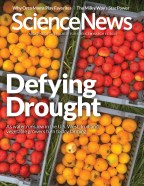Readers react to a dwarf planet’s odd ring, dry farming and more
- More than 2 years ago

Sizing up rings
The dwarf planet Quaoar sports a ring that lies outside the orb’s Roche limit, an invisible line beyond which rings aren’t thought to be stable, Lisa Grossman reported in “This dwarf planet hosts an odd ring” (SN: 3/11/23, p. 11).
Reader Henry Leonard wondered if it’s possible the ring isn’t so unusual, that perhaps Quaoar simply has an unexpectedly large mass, resulting in a large Roche limit.
Astronomer Bruno Morgado of the Federal University of Rio de Janeiro is certain that the dwarf planet’s ring is an oddball. Morgado’s team used the orbital motion of Quaoar’s satellite, Weywot, to determine the dwarf planet’s mass. That revealed that the ring is way outside its Roche limit, Morgado says.
Down the drain
Fifty years ago, scientists discovered that Earth’s oceans slowly drain into the mantle. Today, it’s known that some water cycles back into the oceans, but just how much remains unclear, Erin Garcia de Jesús reported in “Oceans may be shrinking” (SN: 3/11/23, p. 4).
Reader Karen Schaffer wondered how this phenomenon influences sea level rise due to climate change.
The oceans are draining into Earth’s interior via plate tectonics at a much slower rate than they are rising due to modern climate change, says Clint Conrad, a geophysicist at the University of Oslo. About 280 million metric tons of ocean water leaks into the mantle every year, Conrad says. This seems like a lot, but it represents only a tiny fraction of a millimeter of sea level drop per year, he says. In comparison, Greenland and Antarctica together shed about 420 billion tons of ice into the oceans annually, which contributes an average of roughly a millimeter each year to global sea level rise (SN Online: 8/17/18).
At the current rate, the ice sheets will completely melt within about 50,000 years, Conrad says. But the slow and steady loss of ocean water to the mantle will continue for much of Earth’s lifetime. With that said, “the rapid sea level rise occurring right now is, of course, much more important for human society because it produces notable changes during human lifetimes,” he says.
Reader Rashad Blount asked what might happen if the mantle reaches its capacity to hold ocean water. Could that contribute to underwater earthquakes or cracks in Earth’s core?
Setting aside processes that cycle water from Earth’s interior back into the oceans, the mantle and core could probably store all of the seawater on the surface, Conrad says. Doing so would affect the planet’s geology. But rather than cause quakes or cracks, it would most likely boost volcanism, he says. Water tends to decrease the melting point of minerals. So “a more hydrated Earth should have more melted rocks — more magma — and thus more volcanism,” Conrad says. Indeed, the amount of volcanism the planet experiences today might be different if the oceans were not leaking into the planet’s interior, he says.
Take a look at fish
Bluestreak cleaner wrasses (one shown below) recognize themselves in mirrors and photos, suggesting that the animals may be self-aware, Betsy Mason reported in “Fish recognize themselves in photos” (SN: 3/11/23, p. 13). Many readers were not surprised to learn of the fish’s possible self-awareness. Twitter user @amphimanifesto wrote: “I’ve long thought animal self-awareness is probably far more widespread than we think. Our current [underestimation] of its breadth is due to the limits of our current methods of ‘testing’ for it and interpreting the results.”

Tastemaker
Some farmers in the western United States are forgoing irrigation, saving on water and producing more flavorful fruits and vegetables, Katherine Kornei reported in “Betting on dry farming” (SN: 3/11/23, p. 16).
Reader Bill Taylor, a former gardener who sold dry-farmed tomatoes and apples, advocated for the quality of dry-farmed produce. Though such fruits and vegetables are often smaller than ones grown with typical irrigation, “the flavor is more enjoyable,” Taylor wrote. Their size may even be a perk. “On a mountain above Redwood Valley, Calif., [I grew] a dry-farmed apple…. These small apples sold well as ‘lunch box apples’ for kids to take to school.”
Online, the story inspired Twitter user @Rickdalgetty1 to share their experience eating dry-farmed produce: “The [tomatoes] I purchased from a farmer that were grown with minimal water had such concentrated flavor. It was incredible.”